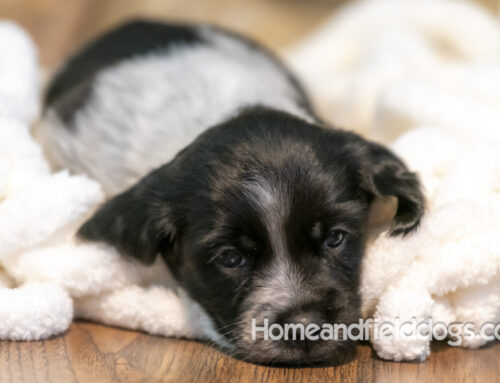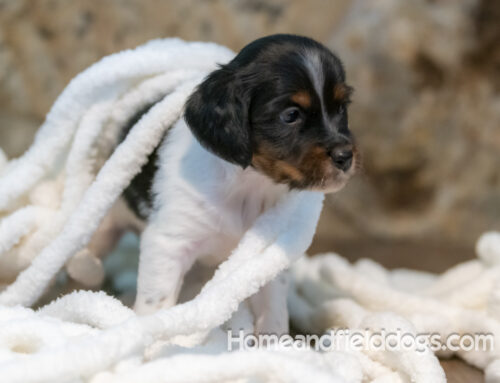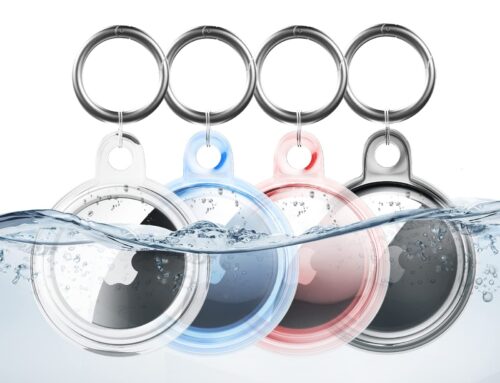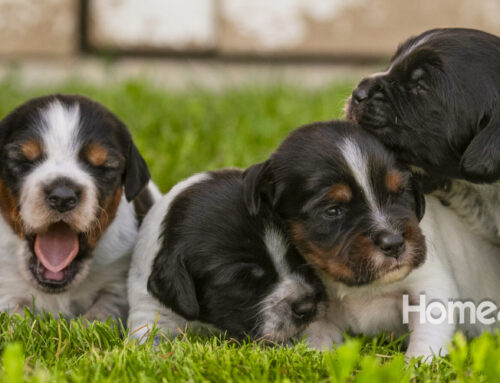If you really want to know my honest opinion, the very most important thing we teach a dog is housetraining. A much wiser man than I and a good friend Dr. Ian Dunbar helped me see that this one thing makes the difference between a dogs success as a family pet and going to the pound.
Now I am not up on my high horse, I realize that for many sporting dog/Gundog owners they keep their dogs in outdoor runs, and if you are keeping your dog clean and healthy and happy in that environment I am not on a crusade to say it should never be done. Dogs can have a healthy happy fulfilling life that way. But it is more fulfilling when they share your home with you.
Dr. Dunbar taught me that people bring a new puppy home, and after so many accidents in the house, it is moved to the basement or somewhere easier to clean up and gets less contact with people. It’s behavior and boredom start to escalate. That causes additional problems and eventually the dog is moved outside on a chain or in a run. There it’s boredom and behavior escalate even more as they receive less and less human contact. They begin destructive habits like digging, nuisance habits like digging, they are dirty and soiled much of the time and no one wants to touch them or be touched by them and soon the only option left is to get rid of the dog.
This is why you simply have to get housetraining underway as soon as the puppy comes home.
First you need to download and ready this book from Dr Ian Dunbar.
There are two absolutely unbreakable rules when it comes to housetraining your puppy:
Rule Number One: If you don’t catch your puppy in the act of peeing or pooping, then just clean it up and forget about it. This is the most important rule and in theory is the simplest but in practice can be very difficult. If you come in even a few minutes after the accident occurred and you scold your puppy, he has no idea why he is being scolded. So many people say “He knows what he did, look how guilty he looks!” If he looks guilty it’s only a response to your anger: a dog’s brain simply doesn’t work in a way that allows him to understand he’s being scolded for something he did at an earlier time. If you don’t catch him in the physical act of doing it, you have to just grin and bear it: doing any different is doing a great disservice to your puppy.
Rule Number Two: Praise your puppy when he does it right. Don’t let the relationship with your dog become one in which your main interaction is saying “No!” when they are caught doing wrong. This means a fair amount of dedication on your part: you have to accompany him outside and praise him when he goes where you want him to. It is also a good idea to select a command (“Go potty”, etc.) and begin using it when he goes so that later you can remind him that you’re outside in the cold so that he can do his business, not just sniff every possible smell! When they do it right, make sure you let them know.
Methods of Housetraining
Crate Training
For me the simplest and quickest method of housetraining involves using a crate or kennel. There are people who believe crates are cruel, but those people don’t understand the basics of dog psychology. Dogs are, by nature, den animals: they like to have a safe place to sleep that is all theirs. And when that place is their crate, they naturally want to keep it clean: no one wants to sleep in a soiled bed! Some people think their dog will be more comfortable in the largest possible crate but in fact they prefer a space large enough to curl up and occasionally stretch out. If the crate is so large that your puppy can urinate or defecate in part of the crate and still curl up in another part away from the mess, then it defeats the purpose of crate training. If you don’t want to buy multiple crates to “grow” with your puppy, you can get the size that will fit him as an adult and use cardboard boxes or other removable barriers to adjust the interior size. Despite their natural inclination to love a den, most puppies do not think being locked away from all the fun is a good idea at the beginning. When you are first introducing your puppy to the crate, it is helpful to give him a chew toy or treat when he goes in, so that he associates the crate with good things. Time in the crate should be limited to 45 minutes to an hour at the beginning, and take him outside to the place where you want him to go immediately after releasing him from the crate. Gradually increase the time spent in the crate, and if your puppy has an accident in the crate just clean it up and forget about it. You don’t want to create an aversion to the crate and it’s not his fault: he likely was left in there too long.
During housetraining, anytime you are not able to give your puppy your full attention, he should be in his crate. Too many people make the mistake of thinking they’re right there with him but then get caught up watching TV, texting, etc. If you can’t commit to watching your puppy closely he should be in his crate to keep him from having an accident in the house. If you’re cooking, playing with the kids or basically doing anything that doesn’t directly involve the puppy, he should be crated. When you can focus on him, take him out, make sure he goes to the bathroom, and then when you bring him back in he can stay out and play. If you take him out and he doesn’t go, though, he should go back in his crate: not as punishment, but rather to make sure he doesn’t then go in the house.
Since you obviously can’t watch your puppy while you’re sleeping, he should sleep in his crate at night starting from day one. Just like a human baby, he won’t be able to hold his bladder all night, so this means you will be getting up to take him out. Don’t worry, as he grows the time he can spend crated will gradually lengthen and soon enough you’ll both be sleeping through the night!
Besides physically keeping your puppy from messing in the house, crate training also teaches your puppy that when he has the urge to urinate or defecate, he can hold it. This is why puppies who have been crate trained typically have fewer accidents later on.
Constant Supervision
If, for whatever reason you opt against crate training, the other method of house training is Constant Supervision. This method involves no papers, pads or crates, rather it is making a commitment to spending basically every waking moment with your puppy. This method only works for people who are in their homes all day (working from home, retired, etc.) and basically involves keeping any eye on your puppy at all times and committing to getting him outside quickly as soon as they see him exhibiting his “pre-potty pattern”. There is much less room for error than with crate training as you have to be constantly on alert. Some people who opt to use this method of housetraining actually tie a leash around their waist in order to physically keep the puppy with them all times. g
Even if you opt for constant supervision I strongly encourage you to get your puppy used to a crate, as there may be times it is absolutely necessary that he be crated and it is best if he is comfortable there. Having worked in the veterinary field I can tell you that crate-trained dogs that have to be hospitalized for any reason are much more relaxed than those that have never gotten used to it. And as we see people evacuated from homes due to fires, floods, etc., those whose dogs are crate trained are much better prepared to handle the stress of everything else going on.
With both methods, it is important that when your puppy is taken outside and does his business he should be praised and brought back inside immediately. You want him to understand that the purpose of going outside is to go to the bathroom, not for play or other distractions.
As mentioned in Rule Number Two above, it is strongly encouraged to use a consistent word when going out to go to the bathroom. Whatever word or phrase you use (“Outside?”, “Go potty!”, etc.) it is important that everyone in the family always use the same word in the same way. It is best to use verbal commands to initiate this sort of activity rather than waiting for the puppy to figure out how to let you know he needs to go. Some puppies will earn to go to the door to let you know, but asking him if he needs to go outside and then taking him out so he can relieve himself will help the puppy see you as part of the activity rather than the door. And again, as soon as he eliminates offer immediate praise and then right back in the house to play, treat, etc. Help him to understand that “outside” is for a purpose. If taking your puppy out to play or go for a walk we don’t use the command even if we know he will eliminate while we are outside: whatever command you use should be used purposefully.
Regardless of which housetraining method you use or how careful you are, the odds are your puppy will still have an accident or two while he’s growing up. Referring back to Rule Number One, it is critical to remember: if you don’t catch your puppy doing it, then there is NOTHING you can do but clean up the mess. Mutter under your breath if you must, but don’t take it out on your puppy! Because to be honest, it was your fault, not your puppy’s. If you’d been watching you would have noticed the signs: suddenly walking or running in circles with his nose down, looking for the perfect spot to go. The puppy will show the same behavior most every time; it’s up to you to be watching for it. And if you do happen to catch him in the act, it is important that you still stay calm. Quickly but calmly pick him up, say no sternly but without raiding your voice, and take him outside, where you will then give the verbal command you use each time. If he finishes going outside, praise him and bring him back in.
Punishment of any sort does not speed up housetraining. Learn your puppy’s patterns: most puppies need to go outside immediately after they wake or finish a robust session of play, and also within 15-30 minutes after eating. Be consistent with your feeding schedule and plan your trips around these patterns.
All of this may seem overly simplistic but it really is simple. Your dog wants to live in a clean environment just as much as you do, so it’s your job to help him understand how to make that happen. Yes, for some dogs it takes longer than others, but with consistency and patience your puppy will get there!






Leave A Comment